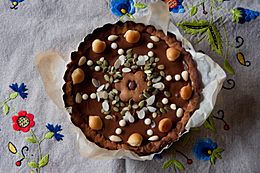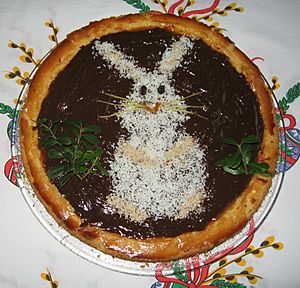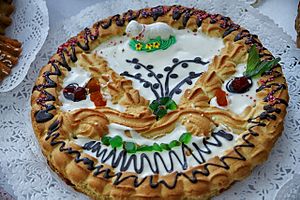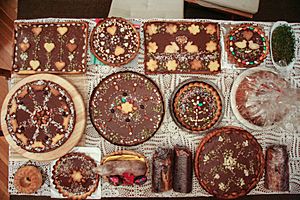Mazurek (cake) facts for kids

Traditional home-made mazurek
|
|
| Alternative names | Easter shortcake |
|---|---|
| Type | Pastry |
| Place of origin | Poland |
| Serving temperature | Room |
| Main ingredients | flour, sugar, butter or margarine, eggs, icing, candied or dried fruits, nuts |
Mazurek is a special kind of flat, sweet cake from Poland. People usually bake it for Easter celebrations.
This cake is often made from one or two layers of a crumbly pastry called shortcrust. Sometimes, a layer of soft sponge cake is added on top of the shortcrust. If there are two layers of pastry, they are usually stuck together with a layer of marmalade. If it's a single layer cake, the marmalade might go on top, under the sweet icing.
The top of a Mazurek is always covered with a sweet layer. This can be sugar icing, a creamy caramel fudge, or even jelly. People love to decorate Mazurek with tasty things like nuts, almonds, and colorful candied fruits. When made at home, these cakes are often decorated with dried fruits and more nuts.
Some Mazurek cakes have raised edges, like a border, made from rolled pastry. Others might have a criss-cross pattern, called a lattice, on top.
Contents
Discovering Mazurek: A Polish Easter Treat
What is Mazurek?
Mazurek is a very flat and sweet cake. It's a traditional dessert in Poland, especially during Easter. What makes it special is how much it's decorated. It often has lots of dried fruits, nuts, and chocolate icing. These decorations also help the cake stay fresh longer.
Where Does the Name Mazurek Come From?
The name "Mazurek" might come from the Mazurzy tribe. These people lived in a part of central Poland called Mazovia. Another idea is that the name comes from "mazurek," which is a traditional Polish folk dance. This dance has a special rhythm called triple metre.
The History of Mazurek
Even though Mazurek is a very Polish cake, its recipe likely came from far away. It probably arrived in Poland from the East, possibly from Turkey. This happened around the early 1600s, through trade routes where spices were exchanged.
Mazurek and Easter Traditions
Why is Mazurek Special for Easter?
Mazurek is closely linked to a Christian period called Wielki Post, or Lent. Lent is a 40-day time of reflection and fasting before Easter. After this period, Mazurek was seen as a sweet reward for staying true to faith and traditions.
Today, the religious meaning of Mazurek is not as strong in Poland. However, the cake is still a very important part of Easter celebrations.
How is Mazurek Decorated?
Mazurek cakes are often decorated with symbols of Easter. You might see hares, pussy willow branches, or messages wishing "Happy Easter."
The Polish news website Wirtualna Polska says that Mazurek should always be flat. It can come in many different flavors and should always be beautifully decorated. It's even traditional to serve many different kinds of Mazurek cakes side by side!
At Christmas, some Catholic traditions involve serving twelve different food dishes. This number is special because it reminds people of the Twelve Apostles at the Last Supper.
Nutty Mazurek: A Traditional Polish Product
The nutty mazurek (also called "nutty Easter shortcake") is a special kind of Mazurek. It was officially added to the list of Polish traditional products in 2011. This means it's recognized as an important part of Polish food heritage.
The base of this cake is made from shortcrust dough. This dough includes ground walnuts, flour, sugar, margarine, a few eggs, and a little bit of sour cream.
After baking, the cake is covered with a thick layer of frosting. This frosting can be a walnut cream or an icing made from sugar, water, and milk powder. Finally, the nutty mazurek is decorated with dried fruits like raisins, almonds, and walnuts. These are often arranged in pretty patterns.
A traditional nutty mazurek is quite flat. It's usually about 20 centimeters (8 inches) by 40 centimeters (16 inches) in size. It tastes very sweet and has a strong walnut smell. Its color is golden or golden-brown.




